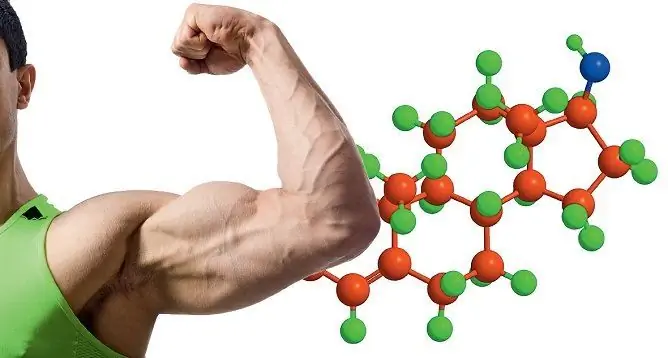- Author Rachel Wainwright [email protected].
- Public 2023-12-15 07:39.
- Last modified 2025-11-02 20:14.
Testosterone levels in men
The content of the article:
- The action of testosterone in the body
- Testosterone levels in men
- Decreased testosterone levels
- Increased testosterone
- Diagnostics
Testosterone levels in men vary greatly depending on age. The peak of hormone production occurs at the age of 18, and after 40 years, the secretion of the hormone begins to gradually decrease.
Testosterone (from Latin testis - male testicle, male strength and stereos - solid) is one of the representatives of the androgen group, which affects puberty and sexual function, provides spermatogenesis, the development of secondary sexual characteristics, and stimulates libido.
This steroid hormone is secreted by the male sex glands (testes) and, to a lesser extent, by the adrenal cortex. In women, small amounts of testosterone are synthesized by the ovaries, adrenal cortex, and peripheral fat cells.
The main amount of testosterone is produced from cholesterol by the interstitial cells of the testis (Leydig cells), which are located in the testicular stroma around the seminiferous tubules. The synthesis of the hormone is facilitated by several sequential enzymatic reactions involving tissue enzymes.
The process of biosynthesis is stimulated by follicle-stimulating (FSH) and luteinizing (LH) hormones. In turn, testosterone suppresses the secretion of pituitary tropic hormones in a negative feedback manner. Gonadotropic hormones also regulate the transport of testosterone into the bloodstream, where it combines with sex hormone binding globulin (a protein of the globulin fraction) and serum albumin. In the globulin-bound form, testosterone is inactive.

Testosterone levels in men change with age
A small part of testosterone circulating in the blood is in free form (about 1-2% of total testosterone). The free fraction of the hormone and testosterone bound to albumin are biologically active (bioavailable testosterone), available for metabolic activation, and easily penetrate androgen-sensitive cells. Once in target cells, testosterone is converted into a more active metabolite - dihydrotestosterone, a small part of the hormone forms the female hormone estradiol with the help of aromatase. The breakdown of testosterone occurs in the liver.
The action of testosterone in the body
The main functions of testosterone and its derivatives in the male body are associated with the formation and development of the reproductive system and sexual characteristics. Testosterone has the following effects:
- regulates the differentiation of the genital organs in the prenatal period;
- is responsible for puberty, stimulates the development of the prostate gland and external genital organs in adolescence;
- forms secondary sexual characteristics;
- stimulates spermatogenesis;
- supports libido, potency;
- inhibits the production of luteinizing hormone in the anterior pituitary gland;
- enhances the biosynthesis of protein in muscles, causes the growth of muscle mass;
- regulates the growth and development of the osteo-ligamentous apparatus, enhances the density and strength of bone tissue;
- determines the psychophysiological characteristics of sexual behavior;
- stimulates the nervous system.
Testosterone levels in men
The norms for total, free and bioavailable testosterone vary greatly depending on age, but also on the method of determination and units of measurement adopted in a particular laboratory. Testosterone levels can be calculated in nmol / L, ng / dL, or ng / ml.
The total testosterone level is a quantitative indicator of all forms of the hormone in the blood serum. The rate of total testosterone in men depends on individual and age characteristics:
- from 18 to 69 years old - 6-38 nmol / l;
- from 70 years - 4-20 nmol / l.
The normal level of free testosterone in a man should fit into the following indicators:
- from 18 to 69 years old - 5.5-42 nmol / l;
- over 70 years old - 4.9-7.3 nmol / l.
There is a calculated indicator that determines the ratio of free and total testosterone - the free testosterone index (IST). IST provides accurate information about the effect of testosterone on target cells, and is used to assess bioavailable testosterone and general androgenic status.
The level of testosterone in men depends on age: the main androgen begins to be produced in the prenatal period, the most significant increase in its level occurs in adolescence, the peak of production falls on 18 years. After 35 years, the secretion of the hormone begins to gradually decrease. After 40 years, the rate of testosterone in men decreases by 1-1.5% per year. After 55-60, androgen deficiency makes it more difficult for men to lose weight or gain muscle mass.
You can roughly determine what the level of testosterone should be using the table of testosterone norms in men by age:
| Age | Testosterone rate, nmol / l |
| newborns | 2.6-13.9 |
| 6-11 months | 0.07-0.24 |
| 1-5 years | 0.07-0.87 |
| 6-9 years old | 0.10-1.04 |
| under 50 | 8.72-38.17 |
| 50 years and older | 6-27 |
Fluctuations in testosterone also depend on the time of day. The highest level is recorded in the morning, by the evening it gradually decreases and reaches a minimum. The concentration of the hormone can vary depending on various factors affecting the body: genetic characteristics, the presence of chronic diseases, psycho-emotional state, physical activity, diet, alcohol, drugs, smoking.
Abnormalities in testosterone secretion can lead to serious disruption of the body's activity.
Decreased testosterone levels
A decrease in testosterone concentration in men can occur for various reasons:
- testicular atrophy (testicular atrophy);
- pathology of the hypothalamus and pituitary gland;
- renal failure;
- diabetes;
- obesity;
- chronic prostatitis;
- insufficiency of the sex glands (hypogonadism);
- testicular feminization syndrome (Morris syndrome).
Bad habits, unhealthy lifestyle, stress and psycho-emotional overload can lower testosterone levels in men.

Signs of low testosterone are muscle weakness, lack of muscle mass
Signs of low testosterone:
- development of the figure and physique for the female type (increased deposition of adipose tissue on the hips and buttocks);
- lack of muscle mass, loss of muscle tone;
- slow growth of hair on the face and body;
- reduced in size penis;
- decreased or lack of sex drive;
- impotence;
- reproductive disorders;
- fragility of bones;
- dryness and laxity of the skin;
- mood problems, depression, fatigue;
- sleep disorders;
- memory impairment, decreased mental capacity;
- vegetative-vascular disorders.
Increased testosterone
An overabundance of testosterone in men may indicate the development of tumors of the genital organs, pituitary neoplasms, dysfunction and hyperplasia of the adrenal cortex, excessive hormonal activity of the gonads (hypergonadism), prostate adenoma, and cardiovascular diseases.
Improper sleep and rest, physical overload, unbalanced diet, irregular nutrition, lack of regular sex life can increase testosterone in men above normal.
Excess testosterone can also be caused by the use of muscle-building steroids or drugs containing androgens.
Symptoms of high testosterone in men:
- baldness, especially when combined with increased body hair growth;
- oily skin, acne;
- aggressive behavior, irascibility, irritability;
- increased sexual excitability, alternation of periods of increased sexual activity with apathy;
- hypertension;
- oppression and atrophy of the testicles;
- infertility.
Diagnostics
The amount of testosterone is determined by a blood sample taken from a vein. Determination of total testosterone in men does not reflect the level of biologically available forms, therefore, in addition to the content of total testosterone, they find out how many percent are free testosterone and the fraction associated with globulin.
Blood must be donated in the morning, on an empty stomach, at least 8 hours after the last meal. Before taking blood, it is permissible only to drink water. The day before taking blood, it is necessary to limit fatty and fried foods, exclude alcohol, and stop taking medications. Testosterone secretion increases after exercise, so it is important to reduce exercise before testing.
YouTube video related to the article:

Anna Kozlova Medical journalist About the author
Education: Rostov State Medical University, specialty "General Medicine".
Found a mistake in the text? Select it and press Ctrl + Enter.






